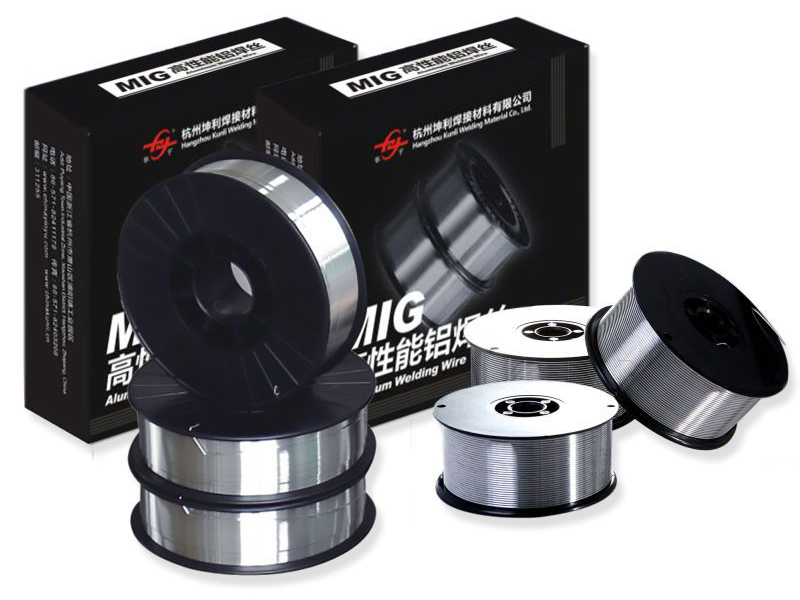How to handle aluminum and aluminum alloy welding wire?
1. Scrub the aluminum plate with alcohol, acetone and a dust-free cloth to remove oil stains on the aluminum plate.
2. Use an angle grinder and a stainless steel polishing wheel to remove the oxide film on the surface of the aluminum plate.
3. After grinding, use a clean stainless steel wire brush to process the surface of the aluminum plate again;
4. After the stainless steel wire brush treatment, use acetone to completely wipe off the dust and aluminum powder on the surface of the aluminum plate.
5. Fix position welding with AC TIG spot.
6. After spot welding, clean the oxide film on the spot welding surface with a stainless steel wire brush again; wipe the dust and impurities on the surface to be welded with acetone and dust-free cloth again (this step is very important).
7. Adjust the welding current and arc voltage (lower voltage, "subjet transition state", a little spatter).
8. Protective gas: the purity of argon is over 99.999%, and the flow rate is 22-24L/min.
9. "Forward method" welding with a gun, the inclination angle of the welding torch is 15-20°, and the dry elongation of the welding wire is 15mm.
10. After welding the first weld, use a stainless steel wire brush to remove the oxide film on the surface, and then wipe it clean with acetone.
11. Weld the surface weld seam, and remove the surface oxide film with a stainless steel wire brush after welding.
12. Remove the aluminum backing plate with a milling machine, mill off the aluminum plate with a depth of 0.5mm, and send it for X-ray inspection.
13. If double-sided welding is used, after the front side is welded, the back must be cleaned with an electric milling cutter, and then the surface oxide film must be removed with a stainless steel wire brush, and then wiped clean with acetone and a dust-free cloth before welding the back seam.
14. Aluminum alloy welding wire Due to the difference between vacuum smelting technology and wire drawing technology, almost all domestic aluminum alloy welding wires have pores, and generally cannot be used on aluminum structural parts for non-destructive testing; if there are flaw detection requirements, it is best to use imported aluminum alloy welding wire .
15. Hydrogen pores are difficult to completely avoid at present. There are many sources of hydrogen, such as hydrogen in the arc atmosphere, aluminum plates, and moisture in the air absorbed by the surface of the welding wire, etc.; the pores can only be suppressed to a certain extent.
16. The argon gas meets the requirements of GB/T4842 standard, and the purity is above 99.999%. However, when the moisture content is ≥ 20ppm, a large number of dense pores will appear, and the X-ray film is unqualified.
17. The relative humidity of the air exceeds 70%, the room temperature exceeds 26°C, and dense pores appear in the weld, and X-ray filming is unqualified.
18. For the welding of tubular aluminum alloy girth welds, the posture of the welding torch is very important! Be sure to use the method on the right side of the figure below. The angle of the welding torch is 70 degrees to the tangent line of the pipe. The weld seam is well protected and formed.
PREV:What are the specifications of aluminum welding wire?
NEXT:What are the common methods of aluminum alloy welding?
NEXT:What are the common methods of aluminum alloy welding?
Related Products
-
 View More
View More
5154 Aluminum Alloy Welding Wire
-
 View More
View More
ER4043 Silicon Aluminum Welding Wire
-
 View More
View More
ER4047 Aluminum Mig Welding Wire
-
 View More
View More
ER5154 Al-Mg Alloy Wire
-
 View More
View More
ER5087 Magnesium Aluminum Welding Wire
-
 View More
View More
Aluminum Welding Wire ER5183
-
 View More
View More
Aluminum Welding Wire ER5356
-
 View More
View More
ER5554 Aluminum Welding Wire
-
 View More
View More
ER5556 Aluminum Welding Wire
-
 View More
View More
ER1100 Aluminum Welding Wire
-
 View More
View More
ER5754 Aluminum Welding Wire
-
 View More
View More
ER2319 Aluminum Welding Wire
 English
English Deutsch
Deutsch
 English
English Deutsch
Deutsch


